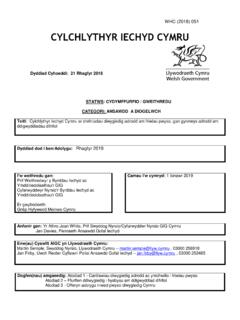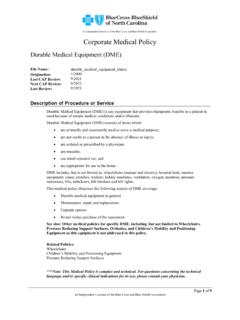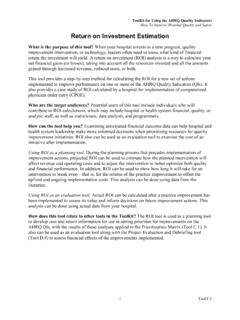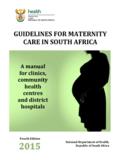Transcription of EXCELLENCE in Continence Care - NHS England
1 1 EXCELLENCE in Continence CareOF THE NHS YEARS 1948 - 2018 England EXCELLENCE in Continence care Practical guidance for commissioners, and leaders in health and social care NHS England Reader Information Box Directorate Nursing Finance Medical Commissioning Operations Patients and Information Transformation and Corporate Operations Commissioning Strategy Publications Gateway Reference: 08266 Document puropse: Strategy Document name: EXCELLENCE in Continence care : Practical guidance for commissioners, and leaders in health and social care Author: NHS England Publication date: June 2018 Target audience: CCG Clinical Leaders, CCG Accountable Offcers, Foundation Trust CEs , Medical Directors, Directors of PH, Directors of Nursing, Local Authority CEs, Directors of Adult SSs, NHS Trust Board Chairs, NHS England Directors of Commissioning Operations, Directors of Finance, Allied Health Professionals, GPs, Communications Leads, Directors of Children s Services, NHS Trust CEs, members of the public Additional N/A circulation list: Description: Practical guidance for commissioners, providers, health and social care staff to put into effect best care Cross ref: N/A Superseded docs: EXCELLENCE in Continence care : Practical guidance for commissioners, providers, (if applicable) health and social care staff and information for the public (November 2015) Action required: N/A Timing/deadlines: N/A (if applicable) Contact details for NHS England , Quarry House, Quarry Hill, Leeds, LS2 7UE further information.
2 Document status: This is a controlled document. Whilst this document may be printed, the electronic version posted on the website is the controlled version. Any printed copies of this document are not controlled. As a controlled document, this document should not be saved onto a local or network drive but should always be accessed from the internet. Equality and Health Inequalities Statement Promoting equality and addressing health inequalities are at the heart of NHS England s values. Throughout the development of the policies and practices cited in this document, we have given due regard to: Eliminate discrimination, harassment and victimisation, to advance equality of opportunity and to foster good relations between people who share a relevant protected characteristic (as cited under the Equality Act 2010) and those who do not share it; and Reduce inequalities between patients in access to, and outcomes from, healthcare services and to ensure services are provided in an integrated way where this might reduce health inequalities.
3 3 EXCELLENCE in Continence CareContents Executive summary 4 Reducing healthcare related harm and costs 5 Commissioning for dignity and value 10 References 20 EXCELLENCE in Continence care 4 Executive summary Continence is an important component in a person s health and well-being at any stage of life and is also an important factor in the use of health resources for the following reasons: Normal bowel and bladder function is an important part of a child s development and their path to adult and independent living. Failure to acquire control in a timely manner will affect schooling and education. Adult incontinence produces marked loss of self-esteem, depression, loss of independence, and can affect relationships and employment prospects. In older people, incontinence and associated bladder and bowel disorders may be associated with physical problems such as skin breakdown, falls, urine infection and catheter associated urinary tract infection which in turn often causes confusion.
4 Confusion can result in falls, head injury or femur fractures requiring an acute hospital admission. Incontinence or dependence on a urinary catheter signifcantly increases the level of dependency in frail older people. This may delay discharge from hospital or initiate a move into a residential or nursing care setting. This guidance is a refreshed and updated e-resource that builds on an earlier publication from November 2015. To help ensure people receive excellent Continence care , consideration should be given to: Early assessment by an appropriately trained professional allows a patient centred and cost effective care pathway to be followed. After assessment the use of containment products, medication and the level of intervention can be triaged and escalated. Effectively resourcing the Continence team and its management structure as part of an integrated service. How local people may need more specialist assessment which should be provided based on population needs.
5 Containment with the use of pads or catheters may be the only realistic option for some people, but this management has associated problems. Actively support the individual to participate in the management and treatment of their Continence care . Simple approaches to care delivery, including electronic and telecommunications, can help people lead healthy lives as well as providing advice and support to implement best practice or services in organisations. Minimum standards which help build competence and knowledge for the workforce involved in Continence care are included in this document. For further supporting information on specifc roles and responsibilities go to Continence This guidance is intended to assist commissioning discussions for those developing high quality community Continence services and provides a valuable supporting resource for the wider STP planning process. 5 EXCELLENCE in Continence care Reducing healthcare related harm and costs The case for change The NHS Five Year Forward View1 puts an emphasis on prevention and keeping people well for longer.
6 Prevention is a key part of any strategy to minimise harm and reduce health care costs. Prevention The Prevention Pyramid The All Party Parliamentary Group for Continence care has designed a Prevention Pyramid showing how risk and costs are reduced where care is underpinned by high quality integrated community Continence services. These services not only provide expert treatment within the community but advice regarding self-help strategies. Skills include training colleagues in initial Continence assessment and conservative treatments and ensuring that referrals to secondary care are made where appropriate. Movement up the pyramid can be delayed or prevented by an integrated Continence service with a traffc light system illustrating the risks and rising costs of untreated Continence needs. In an ageing population, greater prevalence of bladder and bowel problems and the wide range of care groups affected, mean that Continence services require a higher priority.
7 Effective community based Continence services can save valuable NHS resources whilst restoring dignity to people and improving quality of life2. Incontinence is reported as a signifcant reason for care home admissions3. Variation in service provision and practice is a particular area of challenge. There appears to be no consistency as to the frequency of Continence assessments. Physical harm related to complications and treatments for Continence problems for example pressure ulcers, urinary tract infection, catheterisation and faecal impaction can all lead to admission to hospital and care facilities for extended lengths of stay and sometimes permanently. Reviewing the evidence The National Audit of Continence Care4 found that many services were not providing services in line with NICE guidance and that the quality of care is worse among older patients over the age of 65 in whom the condition is most prevalent5, 6.
8 Of women suffering from moderate or severe urinary incontinence, fewer than one third were found to be receiving health or social services for their condition7. EXCELLENCE in Continence care 6 Towards the aim of reducing healthcare related harm and costs, the Leading Change, Adding Value - a framework for nursing, midwifery and care staff8 sets out a systematic way of addressing gaps in services and unwarranted variation across the system. The framework recognises the importance of being able to measure the impact for the improvement of outcomes for local people. The principles embodied in the NHS Improvement programme Getting it Right First Time9 should be applied to Continence care as it recognises the importance of access to early assessment and diagnosis and the focus on improving the patient experience. Towards these aims, pathways of care should be commissioned that ensure early assessment, effective management of incontinence, along with other bladder and bowel problems such as constipation and urinary tract infections and their impact on social, physical and mental well-being and existing comorbidities in order to reduce expensive pad usage, high cost complications and unnecessary hospital and care home admissions.
9 It is estimated that 14 million men, women, young people and children of all ages are living with bladder problems, roughly the equivalent size of the over 60 population in the UK10. It is also estimated that 61% of men in the general population experience lower urinary tract symptoms11, 12 (LUTS) and around 34% of women are living with urinary incontinence13. In addition, 900,000 children and young people suffer from bladder and bowel dysfunction14, 15. Bowel and bladder problems have more impact than almost any other medical condition on children s self-esteem, education and social relationships, and effective treatment can change children s lives (Dr Eve Fleming, ERIC Trustee). million adults in the UK suffer with some form of bowel problem. 1 in 10 of the population are affected by faecal incontinence, with over half a million adults suffering from faecal incontinence, with a negative impact on their lives16.
10 It is likely that of adults experience regular faecal incontinence that affects their quality of life17, 18. Faecal incontinence is closely associated with age (prevalence is about 15% in adults aged 85 years living at home) and is more common in residential and nursing homes19 (prevalence ranges from 10-60%) (APPG 2011; NICE CG171, 2013). Urinary and faecal incontinence are conditions affecting one in three people living in residential care and two in three nursing home residents20. Inadequate management of incontinence can lead to escalating costs due to morbidity and unnecessary hospitalisation. The rate of emergency admissions due to a urinary tract infection (UTI) has almost doubled over the last fve years to 60 per 100,000 population placing additional pressure on acute settings which could often be avoided through early Continence intervention. 7 EXCELLENCE in Continence CareIn 2012/13 unplanned admissions for urinary tract infections (UTIs) cost 432 million per year, averaging million per CCG21.
















